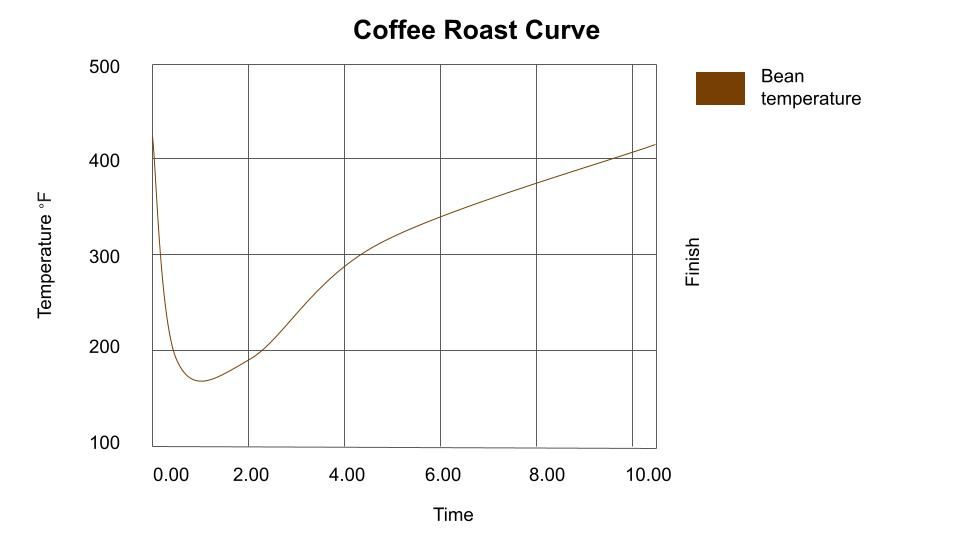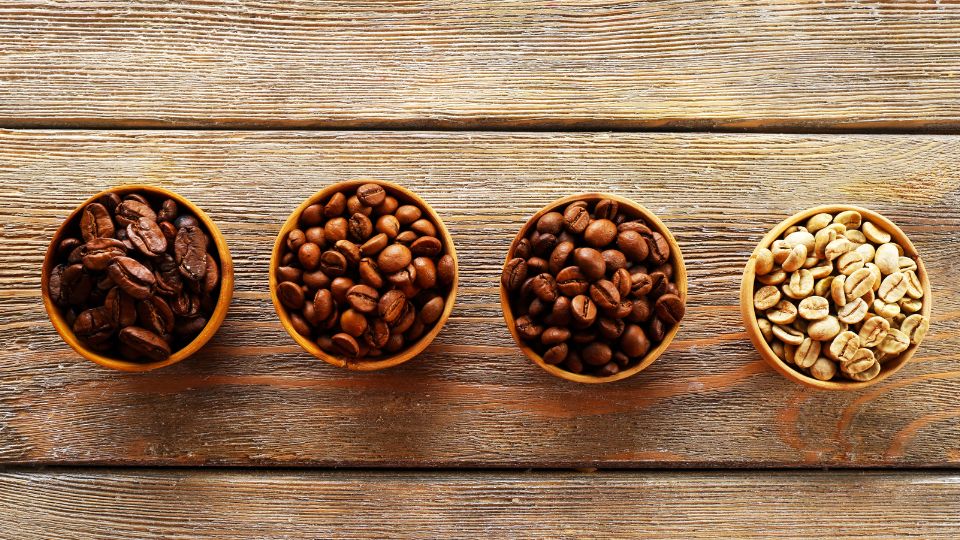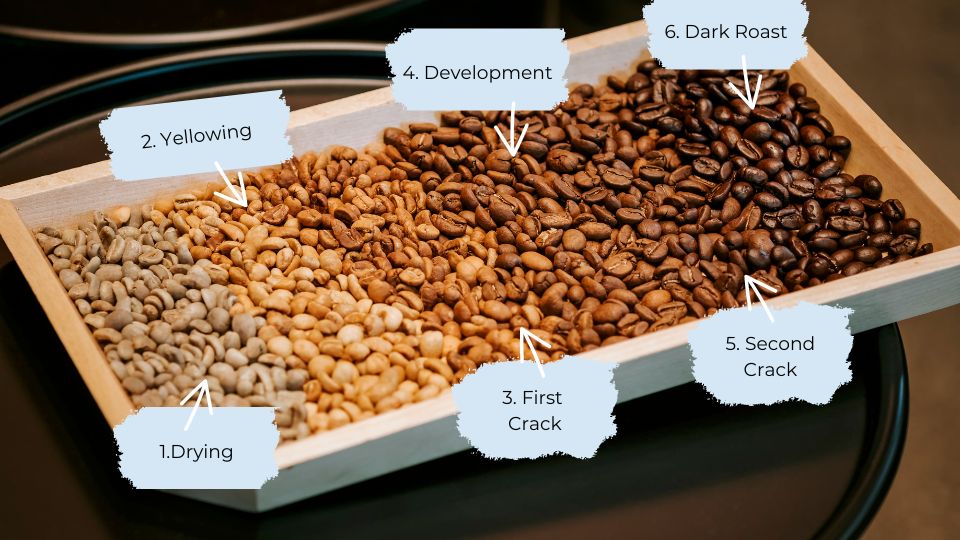During the roasting process, the coffee beans lose their moisture content due to heat, which causes the water molecules to transform into steam and escape from the beans.
This process happens in stages during roasting, including:
- Drying
- Maillard reaction
- First crack
- Roasting, and
- Second crack
What Are The Various Stages Of Roasting Coffee?
Roasting coffee involves several phases, each with distinct characteristics and impact on the coffee’s final flavour profile. The four major stages of coffee roasting are as follows:
- Drying Phase: The moisture content of the coffee beans is reduced during the drying phase. As the beans dry, they will turn yellow, and the aromas will be grassy and hay-like.
- Maillard Reaction: The Maillard reaction happens when the beans reach a temperature between 280-330°F (140-165°C). Sugars and amino acids combine to form complex flavour compounds, and the beans begin browning. The coffee will smell less like grass and more like baking bread.
- First Crack: As the beans heat up, they will begin to make a popping sound known as “first crack.” This sound indicates that the coffee beans are expanding and emitting gases due to a chemical reaction. At this point, the coffee will taste light and acidic.
- Second Crack: As the roasting process progresses, the coffee will enter the second crack phase, distinguished by a louder and faster cracking sound. The coffee will darken and become oilier, and the flavours will become more intense and bitter.
The roaster can adjust the duration and temperature of each phase to achieve the desired flavour profile for the coffee.
The Evaporation Front And The First Crack In Coffee Roasting
“Evaporation Front” and “First Crack” are relevant expressions in coffee roasting. Here is a brief explanation of each:
- Evaporation Front: During the roasting process, moisture from the beans is released in the form of steam. This evaporation process releases moisture from the beans and marks the beginning of a new drying phase.
The humidity in the roasting chamber can be used to monitor the movement of this front as it goes through the beans during the roasting process. The evaporation front is useful because it shows the roaster when to adjust the roasting process. - First Crack: The term “First Crack” describes the moment during coffee roasting when the beans first make a crackling sound. The beans make that cracking sound because the gases they’ve been storing evaporate when the moisture they contain leaves them.
It is common for the first crack to happen at 385°F (196°C), which signifies the beginning of the “light roast” phase. As the beans are roasted longer, their skins will crack and grow in size. For roasters, the first crack is a useful benchmark for determining whether a coffee has reached its optimal roast.
When Does The Moisture Evaporate?
During the initial stage of coffee roasting, known as the drying phase, the moisture in the coffee beans evaporates. The beans are heated to about 212 degrees Fahrenheit (100 degrees Celsius). At this point, their moisture evaporates and is released as steam.
Depending on the type of coffee being roasted, batch size, and roasting equipment used, the drying phase typically lasts for the first few minutes of the roasting process.
Before the next roasting stage, the beans must be completely dried. Any remaining moisture can impede flavour development and cause the beans to roast unevenly.
Roasters pay close attention to the drying phase’s temperature and duration to prevent the beans from being over or under-dried. The beans must be dried until they are pliable enough to be used in the Maillard reaction and flavour development but not so dry that they lose their distinctive qualities.
What Is The Role Of Evaporation In The Roasting Process?
Coffee’s flavour and quality are greatly influenced by how much water is removed during the roasting process. Some of the primary reasons why evaporation is important in the coffee roasting process are as follows:
- Facilitates the Maillard Reaction: The complex chemical reaction responsible for many desirable flavours and aromas in roasted coffee is called the Maillard reaction. The evaporation of moisture from the beans facilitates it.
- Prevents Scorching: The moisture in the coffee beans evaporates during roasting, protecting them from overcooking and burning. Beans cooked in a moist environment are less likely to scorch because the moisture throughout the bean promotes uniform cooking.
- Reduces Weight and Increases Density: Evaporation causes the coffee beans to lose weight and become dense, changes that can affect both the yield and quality of the roasted coffee. Higher-roasted beans with lower moisture content will lose weight and become denser during the roasting process, creating a more concentrated and flavorful end product.
- Allows for Consistent Roasting: By removing moisture that could otherwise affect roasting temperatures and heat transfer, evaporation makes it possible to roast the beans consistently.
- Enhances Shelf Life: Evaporation extends the shelf life of roasted coffee because less moisture is present to oxidise and degrade the flavour over time.
Does Coffee Evaporate During The Roasting Process?
The roasting procedure does cause some of the coffee to evaporate. High temperatures in the roasting chamber cause the coffee beans to generate steam as they release moisture.
Some volatile components that give coffee its flavour and aroma are carried by steam. Roasting causes flavour, fragrance, and colour changes in beans because of the loss of moisture and volatile chemicals.
Several variables can affect the evaporation rate, including:
- The roast profile
- The coffee bean variety, and
- The roasting apparatus
The beans are cooled and bagged after roasting to keep their flavour and aroma intact until they are brewed.
How Much Moisture Does Green Coffee Contain?
Green coffee’s moisture content normally ranges from 10% to 12%. However, this might vary based on factors such as:
- Coffee variety
- Processing method, and
- Storage conditions
Maintaining normal moisture levels in green coffee is critical since it can affect the flavour and uniformity of the roasted coffee. Higher moisture content beans might be more difficult to roast properly, resulting in undeveloped or unevenly toasted beans.
On the other hand, beans with very low moisture content might become brittle and lose some of their flavour and aroma during the roasting process.
Several roasters use moisture metres or other testing methods to measure the moisture content of their beans to ensure consistent moisture levels in green coffee.
Green coffee can also be stored in climate-controlled conditions to reduce moisture variations. Roasters may assist assure a consistent and high-quality finished product by carefully managing the moisture content of their green coffee.
Which Two Physical Changes Occur To The Bean While Roasting?
During the roasting process, coffee beans undergo two distinct physical changes:
| Physical Change | Description |
| Expansion | During the roasting process, coffee beans go through a physical change that is referred to as “expansion.” The beans vary in size, shape, and density as they expand and fracture due to the heat. Due to the escape of water and gases, the beans swell and become less dense, causing the shells to crack open. |
| Colour Change | The coffee’s colour also shifts physically during roasting. As the temperature rises, the beans change colours from green to yellow to brown to black. The amino acids and sugars in the coffee beans break down under heat and produce new chemicals, causing the colour shift. |
How Does Moisture Evaporation Affect Fermented Coffee?
Moisture evaporation impacts fermented coffee during the drying, storage, roasting, and brewing. The water content in beans must be just right for roasting and brewing to work properly. Improper moisture levels can cause uneven roasting and inconsistent extraction, affecting the final product’s quality and flavour profile.
Can Moisture Cause My Espresso To Pull Unevenly?
Moisture can cause uneven espresso pull. Coffee beans lose density and swell when they take in water. This can lead to over-extracted or under-extracted espresso because water is more likely to flow through the less dense areas during brewing.
The coffee grounds can clump together if there’s too much moisture in the air, another factor contributing to an inefficient extraction process. Coffee beans should be kept in an airtight container away from moisture to ensure a consistent espresso extraction.
What Is The Soak In Coffee?
The term “soak” in coffee mainly refers to extracting flavour and aroma from ground coffee beans by steeping them in water. This method may be called “brewing” or “infusing.”
The water permeates the coffee when ground coffee beans are soaked in hot water. It extracts the coffee’s soluble chemicals, such as caffeine, oils, and flavouring compounds.
The time it takes to soak or steep the coffee varies based on the brewing technique and personal preference. Still, it normally spans from a few seconds to several minutes.
Coffee Roasting Tips
Coffee roasting can be complicated, and you may have to try a few things before getting the right roasting level and flavour profile. To get the best taste and smell, it’s also important to use high-quality coffee beans and store them properly.
Here are some tips on how to roast coffee:
|
Roast level |
Roasting Temperature | Roasting Time | Characteristics | Tips |
| Light Roast | 356-401°F (180-205°C) | 7-10 minutes | Fruity, floral flavours, light brown colour, and mild body. | Light roasts are best for simply showing off the coffee bean’s unique flavour profile. It’s important to roast at a low temperature for a short time to keep the coffee’s delicate fruit and floral aromas intact. |
| Medium Roast | 410-428°F (210-220°C) | 10-12 minutes | Medium brown hue, well-balanced acidity and body, and chocolate and nutty flavours. | Medium roasts are the most sought-after because of their well-rounded taste, which includes a pleasing acidity and a medium body. The chocolate and nutty flavours will be enhanced if you roast them longer. |
| Medium-Dark Roast | 437-446°F (225-230°C) | 12-14 minutes | Dark brown appearance, low acidity, fuller body, and bittersweet flavours. | The flavour and body of a medium-dark roast are more robust and complex. To get the desired flavour profile, raise the temperature and roast time. Be careful not to roast it too long, making the food taste burnt or bitter. |
| Dark Roast | 464-482°F (240-250°C) | 14-16 minutes | Extremely deep brown hue; somewhat acidic; richly bodied; smokey, burnt flavours | Dark roasts taste smoky and charred and have a full body with low acidity. Roast at high heat for an extended period to obtain a dark brown hue. But remember that over-roasting can make the coffee taste burnt and hide the flavours of the beans. |

It is crucial to note that these tips are only broad guidelines. The optimal roasting temperature and duration will vary depending on the coffee bean type and individual preference.
Fat Content In Roasted Coffee Beans
The fat in coffee beans is mostly triglycerides, a fat molecule. Triglycerides are broken down and released from coffee beans during the roasting process, resulting in a loss of fat content.
While the fat content of coffee beans is modest, it might affect the flavour and aroma of the coffee. The oils generated during the roasting process can contribute to the richness and complexity of the flavour profile of the coffee, especially in darker roasts. Excessive oil on the surface of the beans, on the other hand, can indicate that they have been over-roasted or are of poor quality.
Weight And Volume Of Green Coffee Beans
The Australian coffee industry, which includes roasters and retailers, normally uses the below measurements. Green coffee beans are often sold by weight in kilogrammes or 60 kg bags, and volume measures can be used to determine bean weight.
However, the actual weight of a certain volume of green coffee beans might differ based on parameters including bean density, roast level, and moisture content.
The following table provides a summary of weight and volume measurements for green coffee beans for roasters and retailers:
| Measurement | Unit | Equivalent |
| Weight | Kilogram (Kg) | 1 Kg = 2.2046 lb |
| Weight | Bag (60 Kg) | 1 bag = 132.277 lb |
| Volume | Litre (L) | 1 L ≈ 0.6-0.7 kg (depending on bean density) |
| Volume | Cubic Meter (m³) | 1 m³ = 1000 L = 600-700 kg (depending on bean density) |
What Is Modelling The Evaporation Front?
Modelling the evaporation front during coffee roasting entails anticipating the behaviour and properties of the interface between the liquid and vapour phases of water and other volatile substances in coffee beans as they are heated and roasted.
The roasting environment’s temperature, the chemical composition of the coffee beans, and humidity constantly fluctuate during the roasting process. Accounting for these changes and forecasting how they affect the rate and amount of evaporation of water and volatile chemicals from coffee beans is part of modelling the evaporation front during coffee roasting.
The use of thermodynamic models that incorporate heat and mass transfer equations, as well as chemical reaction kinetics, to predict changes in temperature, moisture content, and chemical composition of coffee beans during roasting is one approach to modelling the evaporation front during coffee roasting.
These models can also consider the effects of various roasting parameters, such as:
- Air flow rate,
- Time, and
- Temperature profile
Another technique is to employ empirical models based on experimental data to produce more accurate predictions of evaporation front behaviour under certain roasting circumstances. These methods can enhance the roasting process and create new roasting profiles that yield coffee beans with distinct flavour and fragrance characteristics.
How Does This Affect Roasters And What Can They Do To Manage It?
The coffee beans’ moisture content and flavour profile are significantly impacted by the evaporation process, which can be modelled.
Due to evaporation, water is forced out of the beans as steam during roasting. The coffee might have less moisture if the roaster fails to account for the pace and duration of evaporation during the roasting process. Because of this, the coffee’s overall flavour and quality may suffer.
Adjusting the roast’s temperature, airflow, and time are just a few of the methods roasters employ to control evaporation. In addition, they may check the moisture levels of the beans before and after roasting to guarantee uniformity. Software that includes evaporation modelling can also aid roasters in understanding and controlling the process.

What Are The Different Phases Of Coffee Drying?
Coffee drying involves various critical stages in producing a high-quality coffee bean. The following are the stages of coffee drying:
- Pre-drying: After washing the coffee beans, they are spread out in a thin layer to begin the drying process. This first stage eliminates the surface moisture from the beans.
- Transition: During this stage, the coffee beans are transferred to a dryer setting, such as a patio or mechanical dryer, to continue drying. Turning the beans frequently during the drying process ensures that they dry evenly.
- Final Drying: The coffee beans are dried to their ideal moisture level, normally 10-12%. The drying of the beans is closely regulated to avoid over-drying or uneven drying.
- Resting: After drying, the coffee beans are allowed to rest for some time, usually several weeks. This resting period allows the beans’ moisture content to settle and their full flavour to develop.
Each of these stages is essential in producing a high-quality coffee bean. Poor drying can lead to flaws, including mildew, off-flavours, and irregular roasting.
Can Moisture Affect The Duration Of A Roast?
The roasting time can vary depending on the moisture in the food. Roasting coffee beans longer is necessary if they have a high moisture content since more heat is needed to remove the water.
Conversely, if your coffee beans are drier, you can roast them quickly. Coffee roasters must consider the moisture content of their beans when choosing the required roasting time to attain the desired roast level and flavour profile.
How Do You Remove Moisture From Coffee Beans?
The climate, available resources, and desired flavour profile all play a role in choosing the method used to extract moisture from coffee beans. Here are some methods for dehydrating coffee beans:
- Sun-drying: Sun-drying entails scattering the coffee beans in a thin layer and exposing them to the sun. The approach is widely employed in regions with hot and dry weather.
- Mechanical drying: Coffee beans are dried using mechanical dryers that circulate hot air over them as they sit in trays. This approach uses more energy but dries things much more quickly than drying in the sun.
- Vacuum-sealed containers: Coffee beans are stored in airtight containers with desiccants in vacuum-sealed containers to prevent spoilage. Green coffee beans are frequently preserved in this way.
- Silica gel: To keep the coffee beans dry, silica gel packets can be placed in the containers with the beans. Roasted coffee beans are commonly preserved in this manner.
- Freezing: To reduce the moisture in coffee beans, freezing them is a viable option. Unfortunately, this technique is rarely used because it can alter the coffee’s flavour and aroma.
How Does Moisture Affect Coffee Beans?
Moisture content is an important component that influences coffee bean quality in numerous ways:
- Taste and aroma: Coffee beans with a high moisture content may not develop fully during roasting, resulting in a more muted or off-flavour, whereas coffee beans with a lower moisture level may develop more fully and have a more developed, nuanced flavour.
- Storage: While coffee beans with a low moisture level can be stored for extended periods without spoiling, those with a higher moisture content are more susceptible to mildew and decomposition during storage.
- Roasting: Coffee beans with a high moisture content take more time and energy to roast, which might lead to under-roasted, unevenly roasted, or flavourless beans. Yet, coffee beans with a low moisture content require less energy to roast and may have a better-developed flavour.
- Grind consistency: Coffee beans with a high moisture level may not be ground uniformly, resulting in an uneven extraction and a less-than-ideal flavour.
- Brewing: Coffee beans with high moisture content may release too much water during brewing, resulting in weak or diluted coffee. Coffee beans with low moisture content may yield a stronger and more delicious cup of coffee.

What Is The Suitable Method To Determine The Moisture Content In Roasted Coffee?
There are various methods for measuring the moisture content of roasted coffee, each with advantages and disadvantages that rely on factors including cost, accuracy, and ease of use. Following are some ways to determine the moisture content of roasted coffee:
- Oven-drying method: Roasted coffee beans are placed on a baking sheet and dried at 105-110 degrees Celsius until they reach a steady weight. The disparity in weight determines the percentage of moisture.
- Near-infrared spectroscopy (NIRS): This approach uses a spectrophotometer to evaluate the absorption of near-infrared light by coffee beans. The beans’ ability to absorb light is a reliable indicator of their moisture level.
- Karl Fischer titration method: Karl Fischer titration relies on a reagent that reacts with water to ascertain the moisture level. A coffee sample is weighed and then combined with the reagent; the resulting water is tested to determine the coffee’s moisture level.
- Moisture analyzer: The moisture content of coffee beans is determined by heating them and then weighing them to see how much water evaporated during the cooking process.
How Does Moisture Evaporation Benefit Baristas?
Baristas can benefit from learning about moisture evaporation procedures in various ways:
- Improved taste control: Baristas can change their brewing procedures to produce a desired flavour profile by understanding how moisture evaporation affects coffee beans. For example, suppose a barista knows that a specific coffee bean is prone to quickly losing moisture. They might change their brewing procedure to extract the desired taste before the bean becomes too dry.
- Brewing consistency: Moisture evaporation varies depending on the coffee bean, roast level, and brewing procedure. Baristas can create uniform and repeatable brews by understanding how moisture affects coffee beans.
- Increased efficiency: Baristas can adapt their storage and preparation processes to prevent moisture loss by understanding how moisture evaporation affects coffee beans. This can assist in reducing waste and improve the coffee shop’s overall efficiency.
- Enhanced knowledge and expertise: Baristas can enhance their knowledge and expertise by learning about moisture evaporation and its impact on coffee. This will allow them to deliver greater service to their clients by better understanding the subtleties of different coffee beans and brewing processes.
Every barista who aspires to make great coffee should familiarise themselves with the moisture evaporation procedure.
This skill requires great precision and focus, which may be developed through practice. That’s why contacting an accredited barista training provider is crucial.
These professionals can provide comprehensive instruction in all aspects of this brewing technique. And if you have any questions or concerns, they can thoroughly explain the procedure and its science.


